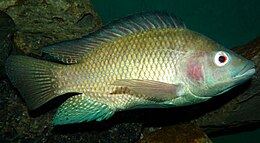Tilapia


Tilapia (/tɪˈlɑːpiə/ tih-LAH-pee-ə) is the common name for nearly a hundred species of cichlid fish from the coelotilapine, coptodonine, heterotilapine, oreochromine, pelmatolapiine, and tilapiine tribes (formerly all were "Tilapiini"), with the economically most important species placed in the Coptodonini and Oreochromini.[2] Tilapia are mainly freshwater fish inhabiting shallow streams, ponds, rivers, and lakes, and less commonly found living in brackish water. Historically, they have been of major importance in artisanal fishing in Africa, and they are of increasing importance in aquaculture and aquaponics. Tilapia can become a problematic invasive species in new warm-water habitats such as Australia,[3] whether deliberately or accidentally introduced, but generally not in temperate climates due to their inability to survive in cold water.
Tilapia is the fourth-most consumed fish in the United States dating back to 2002. The popularity of tilapia came about due to its low price, easy preparation, and mild taste.[4]
History[]

The aquaculture of Nile tilapia goes back to Ancient Egypt, where it was represented by the hieroglyph K1, of the Gardiner list: